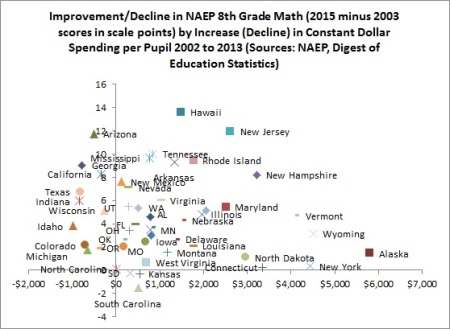(Guest Post by Matthew Ladner)
How did this happen?

As per usual, there is no one single simple answer, but the elephant sitting in Arizona’s K-12 room over the last decade has been abrupt and bracing change in a decades long trend of district enrollment growth and funding increases. Arizona has experienced more than a century of population growth as the rest of you figured out that it was possible not to dig your car out from the snow, and even to play golf in February in Arizona. Arizona K-12 enrollment boomed for decades, with almost all of it going to the districts. In 1995 the first charter schools opened, but at first they were like little mammals scurrying around fearfully in the Age of Dinosaurs.

During the booming age of plenty, the districts were not only getting ever more students, but the spending per pupil steadily increased. Arizona has never been a wealthy state and has long had a relatively small working age population due to the presence of beaucoup retirees and children (relatively large LDS families, immigrants etc.) so this increase was even faster in most states, but was still very large in Arizona:

So in this sort of lost, antebellum Arizona of pre-2007, the school district folks would complain about more of these charter schools popping up, but really they were just whining- spending per pupil had been going up, and they had more pupils than they knew what to do with. Mind you the NAEP of 1992 showed that only 28% of Arizona Anglo students could read proficiently in “English” so a reasonable person could conclude that the districts and their swelling enrollment and growing funding could use a little competition.
As fate would have it, they got competition with both barrels after 2007. In fact, I will have to nominate Arizona as having gone through the mother of all competitive effects.
The Great Recession hit Arizona early and hard. Arizona’s general fund dropped 20% in a single year. When your main industry is building houses on golf courses and all of the sudden everyone nationwide has a difficult time selling their house, your economy takes a beating something like:

Great Recession SMASH AZ economy! Great Recession is the STRONGEST ONE THERE IS!!!!!

I…..wish…..I……could…………spend..more……on……..schools!
So the federal stimulus and a temporary sales tax increase engineered by former Governor Jan Brewer temporarily staved off cuts, but they were eventually necessary and they were not insignificant:

At the same time per pupil spending declined, enrollment growth came to a screeching halt in the districts, in part because of the continued growth of charter schools:

Now mind you that the absolute size of district enrollment was quite modest, but the normal experience for Arizona schools had been non-stop growth for decades. That growth not only stops and reverses a bit, but state assistance per pupil declines as well. Thus at exactly the same time you might want to make up per pupil funding losses with more pupils, you suddenly stop getting as many pupils.
Now as I have written about before, the Newtonian model of K-12 mechanics would have concluded that Arizona’s NAEP scores would have declined under the weight of this pressure. (In fact, Mike Petrilli still owes LGK and I beers on that front….hmmmm….interest accruing daily btw.)
What actually happened during the Great Recession however is that while the economy was smashed, outcomes in schools continued to improve, even defying the national trend in the 2015 NAEP. As the first chart in this post shows, Arizona’s students made more math progress between their 4th grade scores in 2011 and the same age cohorts scores as 8th graders in 2015 than any other state. What gives?

While funding decreased, competition for students increased. An ever higher percentage of students continued to apply to attend charter schools and their waiting lists continued to swell. Fancy Scottsdale Arizona somehow has a couple of empty schools. The state wisely moved to outlaw LIFO in school district layoffs, because layoffs were necessary. A skillful school leader would have taken the opportunity to preserve as many highly effective teachers as possible in this process.
In short, this was a productivity increase that you see in private industry on an ongoing basis. Arizona schools became less expensive and more effective. It is however at complete and utter variance with the state’s history of ever growing budgets and students along with relatively stagnant scores. The Mother of All Competitive Effects (so far) was great for kids and taxpayers, tough on providers and it came about as a combination of deliberate policy and accidental economic catastrophe.
Where do we go from here? Proposition 123 will provide an extra $3.5 billion over the next 10 years, the baby boomer teacher cohort will continue to retire and need replacing, new charter schools will continue to open. Enrollment growth has already returned but the working age population will continue to shrink as a percentage of the total population. The need for further academic gains remains acute. In short, the need for a less expensive and more effective education system is not going away, nor will the political battles surrounding the K-12 debate.
If however Arizona policymakers play their cards skillfully, the state can continue its ongoing move out of the NAEP cellar and towards a world class system of education. Some Arizona schools have already arrived at this enviable spot.
The challenges are very real, but the sky is the limit on our opportunity to improve.




 Posted by matthewladner
Posted by matthewladner 

























